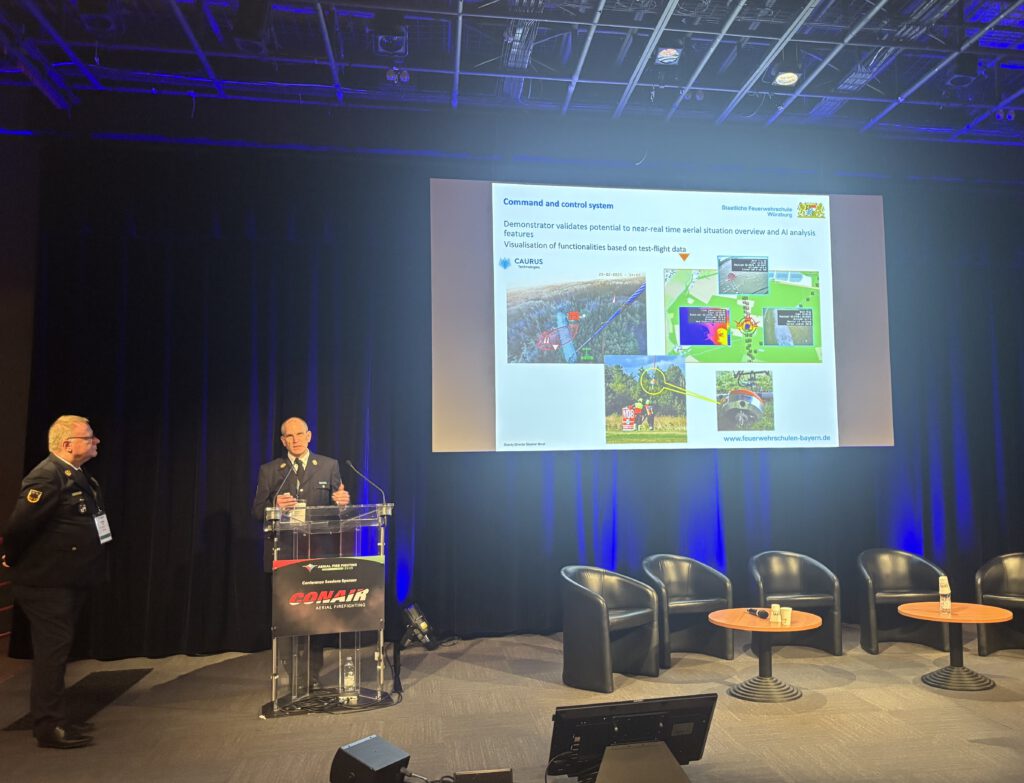
CAURUS Technologies spent two intensive days at the Aerial Firefighting Europe Conference in Bordeaux, France, from March 26 to 27, 2025. Co-founders Philippe und Henrik Telle rubbed shoulders with other firefighting entrepreneurs and most importantly firefighting practitioners. The CAURUS sensor platform was even presented to a larger audience in the innovation part of a presentation by the Bavarian Ministry of the Interior and the Würzburg Firefighting Academy. Representatives of the two organisations shared their experience with firefighting innovation and efforts to prepare for increasingly fierce fire seasons also in Germany.
Much of the two-day discussions revolved around three major questions:
- 1) Are our capacities and capabilities sufficient to adequately respond to changing fire patterns?
- 2) How can firefighting innovation be financed?
- 3) And can existing capacities be efficiently extended and upgraded to manage cycle times and maintenance better?
Here are some of our personal takeaways from the AFFE 2025.

Changing wildfires patterns and the capacity crisis
The challenges posed by changing wildfire patterns exacerbated by climate change are becoming increasingly visible. Wildfires now are occurring out of “fire seasons”. Yet, forward-looking fire season planning isn’t mainstream everywhere yet and preemptive planning only ever comes up as a topic when the fires are already raging. “Exceptional events” now seem to occur every year”, just in different places of the globe. And more area is burnt every year: in 2023, fires in Canada burnt the total area of the past 20 years in just one year.
Auch die Investitionen der letzten Jahrzehnte spiegeln nicht das veränderte Brandverhalten wider. Ein Großteil des Konstruktionsdesigns und der Technologie der alternden Löschflugzeugflotten stammt aus den 1960er Jahren. Vielerorts ist die Ausrüstung knapper als der Bedarf, was dazu führt, dass so manche Bitte um zusätzliche Unterstützung aus benachbarten Regionen oder Staaten unbeantwortet bleibt. Innovationen und neue Technologien zur Waldbrandbekämpfung sind nach wie vor knapp. Und selbst dort, wo ausreichende Finanzmittel zur Verfügung stehen, ist die erforderliche Technologie nicht immer verfügbar: einige öffentliche Ausschreibungen blieben in letzter Zeit trotz deutlicher Bereitschaft zu höheren Preisen ohne Angebote.
At the same time, Ideas and projects are fortunately increasing: development of new aircrafts, small drone-transport enabled water deploying equipment, new retardants or extinguishing agents. Yet, development times of aerial firefighting innovation like new airtankers can take years. Development is costly, and purchasing costs are not limited to the gear “only”: costs for building hangars, maintenance and required certification impede the renewal of existing fleets.
Firefighting department budgets are limited, and additional short-term funding often becomes available only when governments are faced with large-scale, attention-grabbing emergencies. But even such short-term funding cannot procure breakthrough firefighting innovation where there is none or it is still in development.
Continuous asset management focussing on upgrading and efficiency
The alternative solution to this predicament must be long-term and continuous capacity planning and existing asset management. Not only maintenance of existing equipment, but also increasing efficiency through incremental, cost-efficient upgrades come into focus. One US American state provides an interesting case in point: when relevant authorities was faced with massive fires, they realized they were lacking capacities. They requested external help did not arrive as other states also fought fires during the same period and suffered the same problem: limited and ageing firefighting fleets. As a reaction, the authority decided to ramp up their own fleet over the span of five years from 13 aerial means in 2018 to 44 aerial means in 2024, investing around half a billion US dollars. In addition, over a period of three years they spent an additional 120 million USD for maintenance. This situation triggered a rethinking on how to plan budgets for firefighting needs. Today, their budget foresees an annual amount of 50 million US$ for maintenance. The key takeaway here: to keep old and new assets operational, about 10% of the purchasing price should be factored in for maintenance annually.
The CAURUS “bottom line” of AFFE 2025

Vorhandene Kapazitäten sind überall knapp, und die Anschaffung innovativer großer Fluggeräte zur Brandbekämpfung ist kostspielig. Eine aktive Haushaltsplanung muss die Notwendigkeit von Modernisierungen und Kapazitätserweiterungen im Laufe der Zeit berücksichtigen. Sie sollte aber auch Überlegungen einschließen, wie vorhandene Mittel und Kapazitäten mit weniger kostspieligen, aber ebenso wirksamen Instrumenten aufgerüstet werden können. Zum Beispiel Technologien zur digitale Datenerfassung und -verarbeitung, welche “immaterielle”, aber sehr effektive Verbesserungen priorisieren:
- - Improved efficiency of existing aerial means ensure continuity in crisis preparedness.
- Eine verbesserte Effizienz der vorhandenen Luftfahrtflotte gewährleistet Kontinuität bei der Krisenvorsorge
The CAURUS sensor platform is just such an innovation, enabling a cost-efficient upgrade of existing capacities like external load buckets and other assets in the fleets, available short-term. Existing helicopter-based extinguishing practices can be easily, rapidly and cost efficiently upgraded with our system. The CAURUS sensor and AI-based software can be added to existing systems without modifications or changed procedures. Without having to add extra crew and with only minutes to install, the sensor can increase situational awareness on the ground and on board. It thus opens a new dimension of insights DURING the mission and allows incident commands and pilots/operators to make informed decision based on actual data.